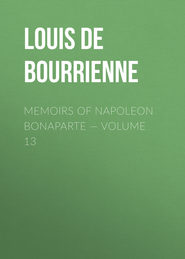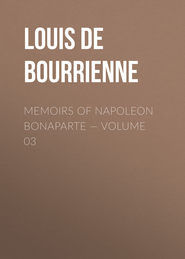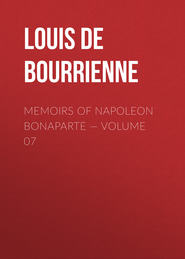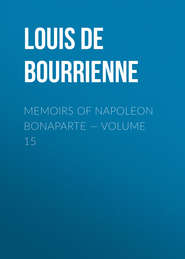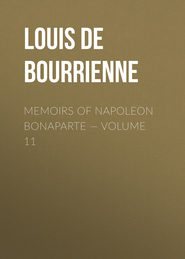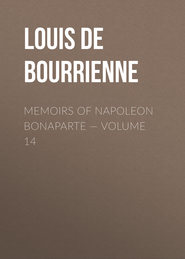По всем вопросам обращайтесь на: info@litportal.ru
(©) 2003-2024.
✖
Memoirs of Napoleon Bonaparte — Volume 16
Настройки чтения
Размер шрифта
Высота строк
Поля
The Emperor had intended his hair (which was of a chestnut colour) for presents to the different members of his family, and it was cut off and kept for this purpose.
He had grown considerably thinner in person during the last few months. After his death his face and body were pale, but without alteration or anything of a cadaverous appearance. His physiognomy was fine, the eyes fast closed, and you would have said that the Emperor was not dead, but in a profound sleep. His mouth retained its expression of sweetness, though one side was contracted into a bitter smile. Several scars were seen on his body. On opening it it was found that the liver was not affected, but that there was that cancer of the stomach which he had himself suspected, and of which his father and two of his sisters died. This painful examination having been completed, Antommarchi took out the heart and placed it in a silver vase filled with spirits of wine; he then directed the valet de chambre to dress the body as he had been accustomed in the Emperor's lifetime, with the grand cordon of the Legion of Honour across the breast, in the green uniform of a colonel of the Chasseurs of the Guard, decorated with the orders of the Legion of Honour and of the Iron Crown, long boots with little spurs, finally, his three cornered hat. Thus habited, Napoleon was removed in the afternoon of the 6th out of the hall, into which the, crowd rushed immediately. The linen which had been employed in the dissection of the body, though stained with blood, was eagerly seized, torn in pieces, and distributed among the bystanders.
Napoleon lay in state in his little bedroom which had been converted into a funeral chamber. It was hung with black cloth brought from the town. This circumstance first apprised the inhabitants of his death. The corpse, which had not been embalmed, and which was of an extraordinary whiteness, was placed on one of the campbeds, surrounded with little white curtains, which served for a sarcophagus. The blue cloak which Napoleon had worn at the battle of Marengo covered it. The feet and the hands were free; the sword on the left side, and a crucifix on the breast. At some distance was the silver vase containing the heart and stomach, which were not allowed to be removed. At the back of the head was an altar, where the priest in his stole and surplice recited the customary prayers. All the individuals of Napoleon's suite, officers and domestics, dressed in mourning, remained standing on the left. Dr. Arnott had been charged to see that no attempt was made to convey away the body.
For some-hours the crowd had besieged the doors; they were admitted, and beheld the inanimate remains of Napoleon in respectful silence. The officers of the 20th and 66th' Regiments were admitted first, then the others. The following day (the 7th) the throng was greater. Antommarchi was not allowed to take the heart of Napoleon to Europe with him; he deposited that and the stomach in two vases, filled with alcohol and hermetically sealed, in the corners of the coffin in which the corpse was laid. This was a shell of zinc lined with white satin, in which was a mattress furnished with a pillow. There not being room for the hat to remain on his head, it was placed at his feet, with some eagles, pieces of French money coined during his reign, a plate engraved with his arms, etc. The coffin was closed, carefully soldered up, and then fixed in another case of mahogany, which was enclosed in a third made of lead, which last was fastened in a fourth of mahogany, which was sealed up and fastened with screws. The coffin was exhibited in the same place as the body had been, and was also covered with the cloak that Napoleon had worn at the battle of Marengo. The funeral was ordered for the morrow, 8th May, and the troops were to attend in the morning by break of day.
This took place accordingly: the Governor arrived first, the Rear-Admiral soon after, and shortly all the authorities, civil and military, were assembled at Longwood. The day was fine, the people crowded the roads, music resounded from the heights; never had spectacle so sad and solemn been witnessed in these remote regions. At half-past twelve the grenadiers took hold of the coffin, lifted it with difficulty, and succeeded in removing it into the great walk in the garden, where the hearse awaited them. It was placed in the carriage, covered with a pall of violet-coloured velvet, and with the cloak which the hero wore at Marengo. The Emperor's household were in mourning. The cavalcade was arranged by order of the Governor in the following manner: The Abbe Vignale in his sacerdotal robes, with young Henry Bertrand at his side, bearing an aspersorium; Doctors Arnott and Antommarchi, the persons entrusted with the superintendence of the hearse, drawn by four horses, led by grooms, and escorted by twelve grenadiers without arms, on each side; these last were to carry the coffin on their shoulders as soon as the ruggedness of the road prevented the hearse from advancing; young Napoleon Bertrand, and Marchand, both on foot, and by the side of the hearse; Counts Bertrand and Montholon on horseback close behind the hearse; a part of the household of the Emperor; Countess Bertrand with her daughter Hortense, in a calash drawn by two horses led by hand by her domestics, who walked by the side of the precipice; the Emperor's horse led by his piqueur Archambaud; the officers of marine on horseback and on foot; the officers of the staff on horse-back; the members of the council of the island in like manner; General Coffin and the Marquis Montchenu on horseback; the Rear-Admiral and the Governor on horseback; the inhabitants of the island.
The train set out in this order from Longwood, passed by the barracks, and was met by the garrison, about 2500 in number, drawn up on the left of the road as far as Hut's Gate. Military bands placed at different distances added still more, by the mournful airs which they played, to the striking solemnity of the occasion. When the train had passed the troops followed and accompanied it to the burying-place. The dragoons marched first. Then came the 20th Regiment of infantry, the marines, the 66th, the volunteers of St. Helena, and lastly, the company of Royal Artillery, with fifteen pieces of cannon. Lady Lowe and her daughter were at the roadside at Hut's Gate, in an open carriage drawn by two horses. They were attended by some domestics in mourning, and followed the procession at a distance. The fifteen pieces of artillery were ranged along the road, and the gunners were at their posts ready to fire. Having advanced about a quarter of a mile beyond Hut's Gate the hearse stopped, the troops halted and drew up in line of battle by the roadside. The grenadiers then raised the coffin on their shoulders and bore it thus to the place of interment, by the new route which had been made on purpose on the declivity of the mountain. All the attendants alighted, the ladies descended from their carriages, and the procession followed the corpse without observing any regular order.
Counts Bertrand and Montholon, Marchand and young Napoleon Bertrand, carried the four corners of the pall. The coffin was laid down at the side of the tomb, which was hung with black. Near were seen the cords and pulleys which were to lower it into the earth. The coffin was then uncovered, the Abbe Vignale repeated the usual prayers, and the body was let down into the grave with the feet to the east. The artillery then fired three salutes in succession of fifteen discharges each. The Admiral's vessel had fired during the procession twenty-five minute guns from time to time. A huge stone, which was to have been employed in the building of the new house of the Emperor, was now used to close his grave, and was lowered till it rested on a strong stone wall so as not to touch the coffin. While the grave was closed the crowd seized upon the willows, which the former presence of Napoleon had already rendered objects of veneration. Every one was ambitious to possess a branch or some leaves of these trees which were henceforth to shadow the tomb of this great man, and to preserve them as a precious relic of so memorable a scene. The Governor and Admiral endeavoured to prevent this outrage, but in vain. The Governor, however, surrounded the spot afterwards with a barricade, where he placed a guard to keep off all intruders. The tomb of the Emperor was about a league from Longwood. It was of a quadrangular shape, wider at top than at bottom; the depth about twelve feet. The coffin was placed on two strong pieces of wood, and was detached in its whole circumference.
The companions of Napoleon returned to France, and the island gradually resumed its former quiet state, while the willows weeping over the grave guarded the ashes of the man for whom Europe had been all too small.






